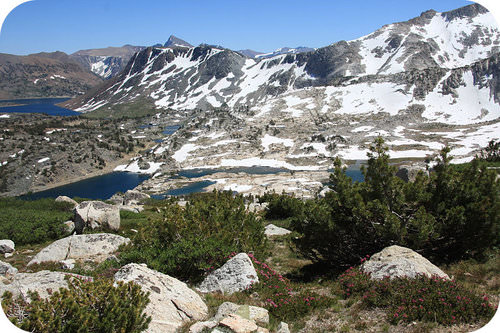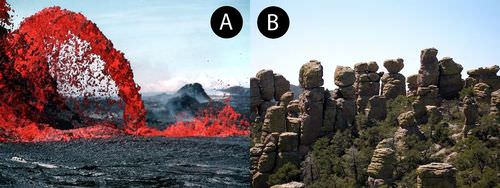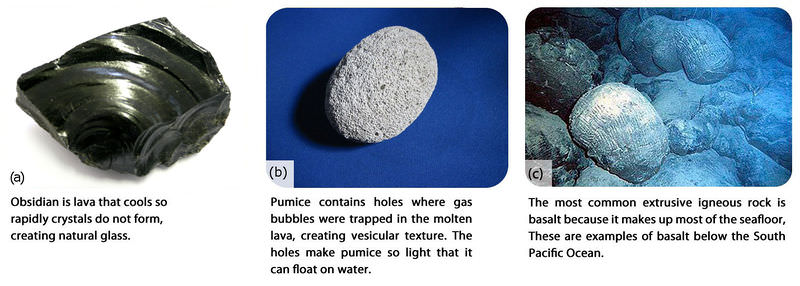4.8侵入和喷出火成岩
章节大纲
-
Are these both igneous rocks?
::这些都是不光彩的岩石吗?These don't even look like they're the same type! They are, at least in the same way that fish and mice are both vertebrates . They both cooled from magma , but the similarities end there. Can you tell what's different?
::它们看起来甚至不像是同一种类型! 它们至少和鱼和老鼠都是脊椎动物一样。 它们都从岩浆中冷却下来,但相似之处就到此结束。 你能看出有什么不同吗?Cooling
::冷却cool from magma. The color of the rock is created by the composition of the magma. The texture is determined by the rate that the magma cools. If the magma cools deep underground, it cools slowly. If the magma cools at or very near the surface, it cools quickly. This results in two different rock types. The rock types can be told apart by the size of their crystals. The size of the crystals creates the texture of the rock.
::从岩浆中冷却。 岩石的颜色是由岩浆的构成形成的。 纹理由岩浆冷却的速度决定。 如果岩浆在地下深处冷却, 它会慢慢冷却。 如果岩浆在地表或很近的地方冷却, 它会很快冷却。 这导致两种不同的岩石类型。 岩石类型可以通过晶体的大小来分辨。 晶体的大小可以创造岩石的纹理。Intrusive Igneous Rocks
::侵扰性岩岩Intrusive igneous rocks cool underground. Deep in the crust , magma cools slowly. Slow cooling gives crystals a chance to grow. Intrusive igneous rocks have relatively large crystals that are easy to see. Intrusive igneous rocks are also called plutonic. A pluton is an igneous rock body that forms within the crust.
::地壳深处, 岩浆冷却缓慢。 缓慢的冷却使晶体有机会生长。 侵扰的有色岩石有相对大的晶体, 很容易看到。 侵扰的有色岩石也被称为浮质。 浮质是地壳内形成的有色岩石体。Granite is the most common intrusive igneous rock. Pictured below are four types of intrusive rocks ( Figure ).
::岩矿是最常见的侵扰性侵扰性侵扰岩块,以下是四类侵扰性岩石(图)。(A) Granite contains mostly light-colored felsic minerals, such as plagioclase feldspar.. (B) Diorite has more dark-colored minerals than granite. (C) Gabbro is mostly made of dark-colored minerals. (D) Peridotite contains olivine and other mafic minerals. Geological processes have brought some intrusive igneous rocks to the surface. Pictured below is a landscape in California’s Sierra Nevada Mountains made of granite that has been raised to create mountains ( Figure ).
::地质过程将一些侵扰性皮质岩石带到了地表。 下面的图画是加利福尼亚州内华达山脉的景观,由花岗岩组成,用来创造山脉(图 ) 。California’s Sierra Nevada Mountains are intrusive igneous rock exposed at Earth’s surface. Extrusive Igneous Rocks
::横流的岩状岩状岩状岩状岩状岩状岩状岩状岩状岩状岩状岩状岩状岩状岩状岩状岩状岩状岩状岩状岩状岩状岩状岩状岩状岩状岩状岩状岩状岩状岩状岩状岩状岩状岩状岩状岩状岩状岩状岩状岩状岩状岩状岩状岩状岩状岩状岩状岩状岩状岩状岩状岩状岩状岩状岩状岩状岩状岩状岩状岩状岩状岩状岩状岩状岩状岩Extrusive igneous rocks form above the surface. The lava cools quickly as it pours out onto the surface ( Figure ). Extrusive igneous rocks cool much more rapidly than intrusive rocks. The rapid cooling time does not allow time for large crystals to form. So igneous extrusive rocks have smaller crystals than igneous intrusive rocks. Extrusive igneous rocks are also called volcanic rocks .
::熔岩在表面上方形成,熔岩随着浮到表面(图示)而迅速冷却。 侵扰性有色岩石比侵扰性岩石凉快得多。 快速的冷却时间不允许大晶体形成。 如此有色有色岩石的晶体比侵扰性岩石小。 外扰性有色岩石也被称为火山岩。(A) Lava cools to form extrusive igneous rock. The rocks here are basalts. (B) The strange rock formations of Chiricahua National Monument in Arizona are formed of the extrusive igneous rock rhyolite. Some extrusive igneous rocks cool so rapidly that crystals do not develop at all. These form a glass, such as obsidian. Others, such as pumice, contain holes where gas bubbles were trapped in the lava. The holes make pumice so light that it actually floats in water . The most common extrusive igneous rock is basalt. It is the rock that makes up the ocean floor. Shown below are three types of extrusive igneous rocks ( Figure ).
::某些极强的有色岩石冷得如此之快,晶体根本无法发展。这些岩石形成玻璃杯,如奥比西迪亚。其他的,如浮石,含有气泡被困在熔岩中的洞洞。这些洞使浮石变得光亮,以至于在水中漂浮。最常见的有色岩石是岩浆。是洋底的岩石。下面显示的是三种有色有色岩石(图示 ) 。Different cooling rate and gas content resulted in these different textures. Summary
::摘要- Intrusive igneous rocks cool from magma slowly in the crust. They have large crystals.
::地壳岩浆缓慢地从岩浆中冷却下来,它们有大晶体。
- Extrusive igneous rocks cool from lava rapidly at the surface. They have small crystals.
::岩浆迅速从熔岩中冷却下来,它们有小晶体。
- Texture reflects how an igneous rock formed.
::质地代表了 一颗不光彩的岩石是如何形成的
Review
::回顾- How do intrusive igneous rocks form? What is another name for these rocks?
::侵扰性有色岩石如何形成?这些岩石又叫什么来着?
- How do extrusive igneous rocks form? What is another name for these rocks?
::这些岩石又叫什么来着?
- How can you use texture to determine whether an igneous rock is intrusive or extrusive?
::您如何使用质地来确定有色岩是侵入性的还是扩张性的?
Explore More
::探索更多Use the resource below to answer the questions that follow.
::利用以下资源回答以下问题。- How are intrusive rocks formed?
::侵扰性岩石是如何形成的?
- What size are the crystals in very coarse rocks? Why are they that size?
::非常粗糙的岩石中的晶体大小是多少?为什么它们那么大?
- What are the most common coarse rocks?
::最常见的粗糙岩石是什么?
- How are extrusive rocks formed?
::震动岩石是如何形成的?
- List the three textures for extrusive rocks.
::列出震动岩石的三个纹理。
- Describe rhyolite.
::描述Rhyolite。 描述rhyolite。
- Describe pumice.
::描述一下虚伪。
- Explain why obsidian appears black.
::解释一下为什么奥比西迪安看起来是黑色的
- Intrusive igneous rocks cool from magma slowly in the crust. They have large crystals.




